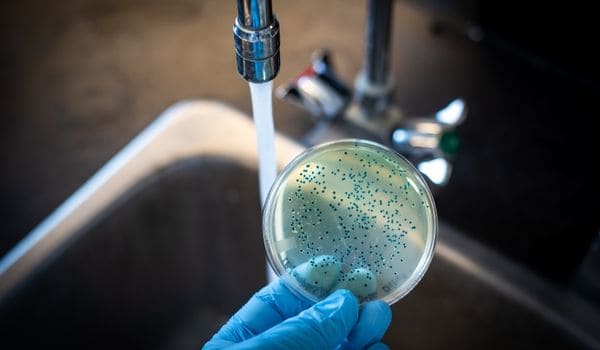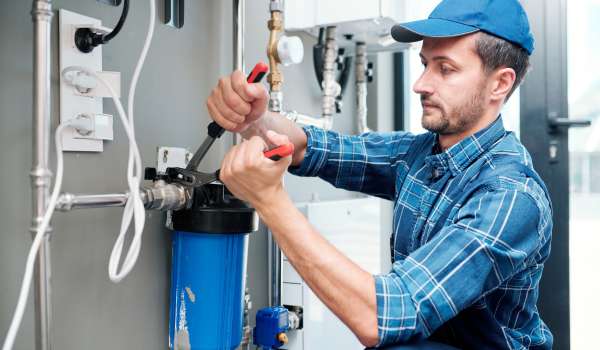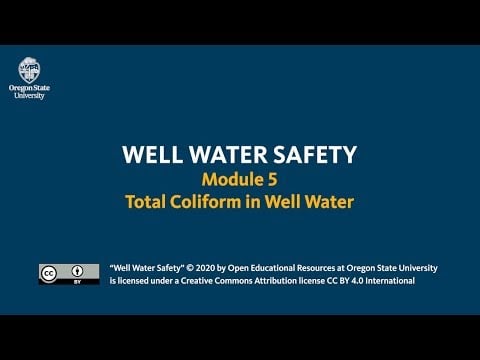Getting a water test back with coliform bacteria can feel alarming — but you’re not alone, and the good news is, it’s usually fixable.
Coliforms show up in well water more often than most homeowners expect. Acting quickly, knowing what your results mean, and taking the right next steps can make all the difference.
🧠 Let’s break it down — no panic, just clear answers and real solutions.
⚡ Quick Takeaway:
- 🧪 Coliforms = red flag — they don’t always make you sick, but they may point to more dangerous bacteria like E. coli.
- 🚱 E. coli detected? Stop drinking the water until it’s treated.
- 💧 Most coliforms come from runoff, septic leaks, or cracked well components.
- 🔥 Boil your water or switch to bottled if your well tests positive.
- 🛠️ Shock chlorination is often the first fix — but persistent results may call for a longer-term solution.
- 🧾 Annual water testing is key — even if your water seems clean and clear.
🦠 What Are Coliform Bacteria, Really?

Coliforms are bacteria that live in: soil, plants, and the intestines of people and animals. Most of them aren’t harmful on their own — but if they show up in your well water, that’s a warning sign.
Why? Because coliforms often come from the same places as harmful bacteria like E. coli, which can make people seriously ill.
🔬 Key concern: If your water has coliforms, there’s a chance other microbes could be present too — even if your test didn’t catch them yet.
🌧️ How Does Bacteria End Up in Your Well?

It doesn’t take much. Coliform bacteria usually slip into your water through cracks, leaks, or runoff — especially after heavy rain. It’s more common than you’d think.
Here’s how they sneak in:
- 💩 Leaky septic systems – Wastewater seeping into the ground can drift toward your well.
- 🐄 Farm runoff – Animal waste and fertilizers can seep into the water table after a storm.
- 🕳️ Cracked well casings – Even a tiny gap gives bacteria an open invitation.
- 🌊 Flooding – Shallow or older wells can get overwhelmed when floodwater pushes contaminants in.
- 🏡 Poor placement – Wells too close to septic fields, barns, or drainage ditches are at higher risk.
📌 Pro tip: Even a well in good condition can get contaminated if the surrounding area isn’t managed properly. A yearly well inspection can catch small problems before they turn into big ones.
🧪 What a Positive Coliform Test Really Means
Not all test results are created equal. When you get a positive coliform result, it’s important to look at the details. Here’s what the different terms usually mean:
- 🔍 Total Coliforms These include both harmless and potentially harmful strains. If this shows up on your test, it doesn’t mean you’re doomed — but it does mean something could be wrong with your well or plumbing.
- 💩 Fecal Coliforms This group lives in the guts of warm-blooded animals. If your water tests positive for these, it means waste has found its way into your system — and fast action is critical.
- 🚨 E. coli This is the most specific and serious result. E. coli is a type of fecal coliform, and some strains can cause major health problems. If it shows up in your water, stop drinking it immediately and switch to bottled or boiled water until it’s resolved.
📌 Helpful to know: Coliforms are used as “indicator bacteria” — kind of like a smoke alarm. They’re easier to detect than dangerous bacteria and often show up first, giving you a heads-up before something worse hits your tap.
🧪 What To Do If Your Well Water Tests Positive for Coliform

Finding coliform bacteria in your well water doesn’t always mean danger — but it does mean it’s time to take action. Here’s how to stay safe:
- 🚱 Stop drinking the water: Use bottled or boiled water until the issue is resolved.
- 🔥 Boil before use: A rolling boil for at least 1 minute kills most bacteria. 👉 Boiled vs. Filtered Water – Which Is Safer?
- 🧪 Retest your water: Use a certified lab test to confirm the results. Tap Score is one we trust for accurate readings.
- 🔍 Check your surroundings: Leaky septic tank? Damaged well cap? Recent flooding? All can introduce bacteria.
- 🛠️ Fix the source if possible: Stopping contamination at the source is the only way to prevent it from happening again.
💡 Pro Tip: Coliform can sneak in through the smallest cracks or leaks. A professional inspection may help if you’re not sure where to look.
💦 What Causes Coliforms in Well Water?

Coliforms are surprisingly common in private wells — and most issues boil down to how groundwater and surface contamination mix.
Here are a few of the biggest culprits:
- 🧻 Leaky septic systems – Wastewater can seep into the soil and contaminate nearby wells, especially if tanks are aging or overfilled.
- 🚜 Agricultural runoff – Heavy rains can wash animal waste and fertilizer into the ground, introducing bacteria.
- 🌧️ Flooding – Shallow wells are particularly vulnerable after major storms or seasonal flooding.
- 🧱 Damaged well components – A cracked casing or loose well cap can create a direct path for bacteria to sneak in.
💡 Helpful to know: Even a well that’s been reliable for years can develop problems. Annual inspections and testing go a long way.
🧼 How Do You Get Rid of Coliform in a Well?
Once you know your water’s been contaminated, the next step is clearing it out — and keeping it out. Here are the most effective ways to remove coliform bacteria from your well water:
| 🔧 Treatment Method | 💬 What It Does |
|---|---|
| 🧪 Shock Chlorination | Flushes the well with a high dose of chlorine to kill bacteria. Good for one-time cleanups — but may need repeating if the source isn’t fixed. |
| 🧼 Chlorine Injection | Adds small amounts of chlorine continuously to disinfect your water. Pairs well with a carbon filter to remove taste and odor. |
| ☀️ UV Filtration | Blasts incoming water with ultraviolet light to neutralize bacteria. Great for chemical-free, ongoing protection. |
| 🔥 Distillation | Boils water and collects the steam — removing bacteria and nearly everything else. Ideal for drinking water, not whole-house systems. |
💡 Good to know: Shock chlorination is a great first step after contamination, but if bacteria keep coming back, it usually means there’s an ongoing source — like a cracked casing or surface runoff issue.
🛡️ How to Keep Coliform Bacteria Out of Your Well

The best fix is one you don’t need later. If you’ve dealt with coliform once, here’s how to make sure it doesn’t come back.
- 🧻 Maintain your septic system Have it pumped and inspected every 3–5 years. Leaks from septic tanks are a leading cause of coliform contamination.
- 🧱 Check your well casing and cap Cracks in the well casing or a loose cap can let bacteria in. If you’re unsure, call a professional to inspect it thoroughly.
- 🧯 Keep animal waste away from the well If you’ve got pets or livestock, make sure they’re not doing their business uphill from your well — runoff flows downhill.
- 🌧️ Be flood-aware After major storms, shallow wells are especially vulnerable. If your well flooded, test the water immediately before drinking.
- 🧪 Test once a year — at least The CDC recommends annual testing for coliform, nitrate, pH, and other common well issues. It’s your best early warning system.
💡 Quick Note: If your well is older or you’ve had recurring issues, consider a water treatment system designed specifically for wells.
🧠 Final Thoughts
Finding coliform bacteria in your well water is never fun — but it’s also not the end of the world. In most cases, it’s fixable with the right steps and a bit of upkeep.
Whether you shock the system, upgrade your treatment setup, or just add a layer of protection like UV, the key is acting quickly and staying proactive.
💡 If this isn’t your first contamination issue — or your well is showing its age — it might be time to consider a more permanent solution. Here’s a look at solid roundup of options that can keep your water safe for the long haul.
Your well, your water — your move. Just know you’ve got options.
 152 people found this helpful. Was this guide helpful to you?
152 people found this helpful. Was this guide helpful to you? 


